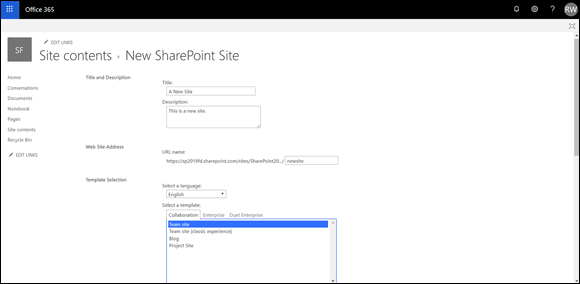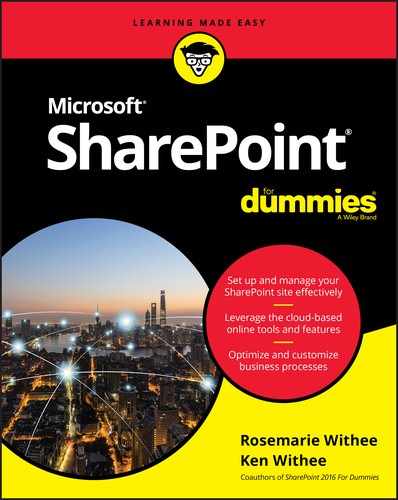Chapter 3
Wrangling SharePoint Functionality
IN THIS CHAPTER
![]() Understanding the functionality that makes up SharePoint
Understanding the functionality that makes up SharePoint
![]() Finding out how SharePoint components fit together
Finding out how SharePoint components fit together
![]() Discovering which functionality is most important to you
Discovering which functionality is most important to you
The reason SharePoint is so difficult to define is that it’s a product that has a tremendous amount of functionality. SharePoint has functionality for administrators, business users, report developers, analysts, programmers, and just about anyone else in any organization. You name it, and SharePoint provides functionality designed for that particular user. Coming to terms with the vastness of SharePoint is a key concept in learning about the product.
In this chapter, you discover some of the main functionality that makes up SharePoint. You find out about SharePoint templates and how they’re used to create websites. You discover the importance of the Team Site template, but find out it isn’t the only game in town. You explore apps and see that almost everything in SharePoint is an app. Finally, you take a high-level fly-over of some of the most common functionality in SharePoint. The whole smorgasbord of functionality is really the definition of SharePoint, and you get a bird’s-eye view in this chapter.
Coming to Terms with Website Templates
If you haven’t experienced SharePoint before, you might think that creating a new website is difficult. Before SharePoint, you would need to gather up the right files and write HTML code to create a website. Tweaking the code and building the website were burdensome tasks. To make matters worse, you had to fiddle with the web server and the security and get everything just right. In short, you needed an advanced level of technical expertise. Some would have argued you needed an advanced degree in computer science! Making changes to the website after it was completed required the same advanced skillset. One of the main reasons SharePoint took off was that it allowed people to create and manage websites with advanced functionality, such as content management and workflow, without needing an advanced technical skillset.
Creating a SharePoint website is as easy as a few clicks of the mouse (assuming you have the right permissions). The primary decision you need to make when you create a SharePoint site is which template to use. Choosing a template is accomplished on the New Site Creation screen, shown in Figure 3-1. Instructions for creating a new site are briefly outlined in Chapter 1 and further detailed in Chapter 5.

FIGURE 3-1: Choosing a template on the New SharePoint Site screen.
Show Me the Apps
SharePoint 2019 extends the way you think about adding functionality to a site. In previous versions of SharePoint, all containers were considered a type of list. What a list meant was fairly generic. You might have a list that provides calendar functionality, or you might have a list that provides discussion board functionality. The concept of a special list with some functionality was one of the hardest things to get our minds around when we started working with SharePoint. SharePoint 2019 removes the confusion by calling everything an app. Instead of a specialized calendar list, you now have a Calendar app. Need a discussion board? You now add the Discussion Board app.
Microsoft has also expanded the ability to develop custom solutions for SharePoint called add-ins. The result is that third parties or in-house developers can create add-ins for any purpose you can conceive. Imagine you’re in Accounts Payable and you use SharePoint 2019 to manage your invoice documents. You might request an add-in from your IT department to route documents through the various approvals before finally being submitted to the payment system.
If you use SharePoint Online, you can browse, purchase, and install apps and add-ins from the SharePoint Store without leaving SharePoint. It’s similar to using the App Store on an iPhone or the Google Play store on an Android phone to buy and download an app.
New in SharePoint 2019 is the ability to use apps on your mobile device as well. Since so many things are called “apps,” this can lead to some confusion. Just remember that an app can live inside a web browser or on your mobile phone. And on your mobile phone you can use the main SharePoint Mobile App or you can create your own SharePoint apps using PowerApps, which we cover in detail in Chapter 16. For example, now you can take your Accounts Payable app that you built using a SharePoint list and turn it into a real live iOS or Android app that people install directly on their devices. The backend is still using SharePoint, but you have expanded your regular SharePoint web-based app into the mobile realm.
Working with Web Pages
A SharePoint site wouldn’t be very interesting without content. A SharePoint site is a container for pages. Pages in turn are a container for actual content; developing pages allows you to add content to your SharePoint sites.
Under the covers there are different types of pages you can create but Microsoft has removed a lot of the complexity and makes getting started with create a generic page much easier.
To create a simple page:
- Open a web browser and navigate to your SharePoint site.
Click the gear icon in the upper-right corner and select Add a Page.
An empty Site page template appears, as shown in Figure 3-2.
- Develop the page by clicking the plus (+) icons and adding components.
When you are ready to publish your page, click the Publish button.
Your page will be published and you will be offered some common tasks such as adding the page to your SharePoint sites navigation, posting the new page as News on the site, emailing the page, and copying a direct link to the page. The dialog for doing these tasks is shown on the right side of Figure 3-3.

FIGURE 3-2: Adding components to a new SharePoint page.

FIGURE 3-3: Publishing a new SharePoint page.
You learn how to create different types of pages in Chapter 6.
The four primary types of pages that can be created and developed from the browser in SharePoint 2019 are:
- Site page
- Wiki page
- Web Part page
- Publishing page
Following is a brief overview of the four types of SharePoint pages.
Site page
A site page, which is the page you created in the earlier exercise, is a standard page that allows you to add components and content without needing much up-front planning. Using a Site page, you can quickly get content onto a page and shared with others around your organization. The Site page is new and was designed to make the onramp to using SharePoint less of a burden for newcomers.
Wiki page
A Wiki page, also known as a content page, is the Swiss Army knife of pages and allows for easy development and customization using a rich text editor built right into the browser. A Wiki page is easy to develop and is an extremely powerful and intuitive collaboration, data capture, and documentation tool.
Web Part page
A Web Part page provides Web Part zones where you can drag and drop various Web Parts from the gallery. A Web Part is a reusable piece of functionality that can be dragged and dropped right onto your pages. A number of Web Parts are available right out of the box, and Web Parts can also be custom developed to meet your specific needs. Imagine a Web Part developed specifically for your organization. After the Web Part is deployed, you could add that custom Web Part to any page you work with on any site in your organization.
Web Parts are discussed later in this chapter and in more detail in Chapter 6.
Publishing page
The publishing page is designed to separate the functionality between managing content and managing the look and feel of the page. A publishing page is only available when certain features are turned on by site administrators. All publishing pages live in a special library called Pages. The Pages library is created automatically when the publishing features are turned on for the site. These pages use a special library because the Pages library already has preconfigured functionality such as versioning and workflow that is designed for the management and distribution of content, or in other words, publishing content.
Chapter 6 covers creating and developing pages.
Understanding Web Parts
A Web Part is one of those fairly rare things in technology that has a descriptive name: A Web Part is a part of a web page. You can think of a Web Part as a bundled piece of web functionality that can be added to a SharePoint page.
SharePoint 2019 has a number of Web Parts available that you can add to your pages. You add a Web Part using the Web Part Gallery, shown in Figure 3-4.

FIGURE 3-4: The Web Part Gallery in SharePoint 2019.
In addition to the Web Parts that ship with SharePoint, you can also add custom Web Parts to the Web Part Gallery. A number of third-party developers create Web Parts that can be purchased; Web Parts can also be developed by in-house SharePoint developers.
Web Parts are covered in more detail in Chapter 6.
Digging into SharePoint Features
Terminology is often a central point of confusion in most technology. SharePoint is no different. For example, the term feature means some sort of functionality or grouping of functionality. In SharePoint, the word feature has a very technical meaning: a collection of SharePoint functionality that can be activated and deactivated. When SharePoint programmers hear the term feature, they immediately think of a particular technical part of SharePoint. SharePoint programmers can bundle together a grouping of functionality they have developed for SharePoint into a single feature. Programmers might develop a bundle of functionality and package the entire thing into a single feature that users can activate or deactivate. For example, if you work in financial services, you might need a number of workflows, pages, images, and custom Web Parts on your SharePoint site. A programmer could build all of this functionality for you and package it all into a feature. When you’re ready to use the functionality, you activate the financial services feature.
Microsoft developed a number of features that ship with the SharePoint product. You can view these features on any SharePoint site as long as you’re an administrator. For example, the Mobile Browser View feature ships with SharePoint 2019; it provides a view of SharePoint data specifically designed for smartphone browsers (see Figure 3-5).

FIGURE 3-5: The Mobile Browser View feature in SharePoint 2019.
Features are covered in detail in Chapter 17.
Integrating with Office 2019
One aspect of SharePoint that fails to get as much attention as it deserves is its integration with Microsoft Office. If you use Office products such as Word, Excel, PowerPoint, OneNote, and Outlook, then you’re already primed to leverage SharePoint. In fact, you might be working with SharePoint from within Office and not even realize it!
Working with SharePoint from within Microsoft Office products is covered in Chapter 9.

 A SharePoint site template outlines what functionality the site will include after it’s created. You can always add or remove functionality as you see fit. Keep in mind that the templates you see depend on a number of factors including the edition of SharePoint you are using, whether you are using SharePoint Online or SharePoint On-Premises, and which features are activated.
A SharePoint site template outlines what functionality the site will include after it’s created. You can always add or remove functionality as you see fit. Keep in mind that the templates you see depend on a number of factors including the edition of SharePoint you are using, whether you are using SharePoint Online or SharePoint On-Premises, and which features are activated.